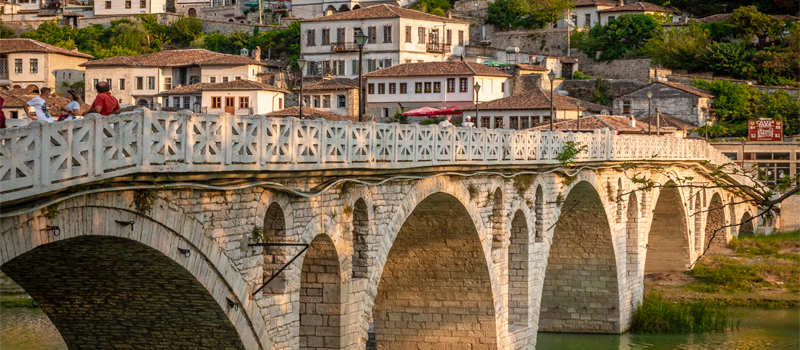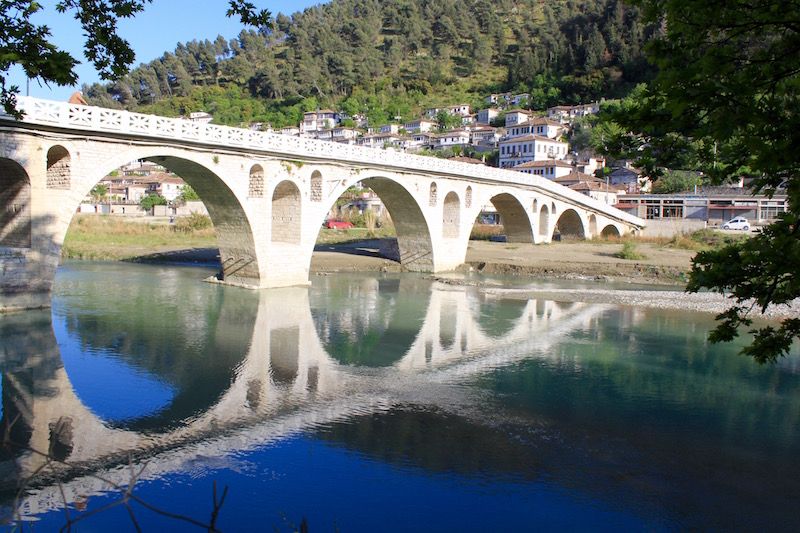
Key Takeaways
-
- The Gorica Bridge (*Ura e Goricës*) is a historic Ottoman-era structure spanning the Osumi River in Berat, Albania.
-
- Built in the late 1700s, it has undergone several reconstructions, blending traditional stone and timber with modern concrete reinforcements.
-
- The bridge is a symbol of Berat’s resilience, connecting the historic neighborhoods of Mangalem and Gorica.
-
- Legends and folklore describe the bridge as a mystical protector and a testament to community unity.
- Today, it remains a popular spot for both locals and tourists, offering stunning views and a glimpse into Berat’s rich history.
Table of contents
The Gorica Bridge (*Ura e Goricës*) isn’t just a crossing over the Osumi River—it’s a living monument of Berat’s vibrant history and cultural resilience. As you stand on its arches, you become part of a story that spans over two centuries, connecting past and present in a seamless embrace.
Historical Background
Construction & Origins
The Gorica Bridge traces its roots back to the late 1700s, during the expansive Ottoman period. Built using locally sourced stone and timber, bonded with lime mortar, it exemplifies traditional craftsmanship. Its primary purpose was to improve connectivity between Berat’s neighborhoods, facilitating trade and daily movement.
Over centuries, natural wear and disasters prompted several reconstructions. In the 1920s, engineers introduced concrete to strengthen the structure, marking a shift from purely Ottoman techniques to modern engineering influences. These efforts preserved its essential function while enhancing durability.
Key Historical Events
This bridge was a vital artery for Berat’s commerce during the Ottoman era, connecting the bustling bazaar of Berat with surrounding regions. Its strategic position became even more apparent during World War II, serving as a route for military movement and resistance activities. Local stories recount how resistance fighters gathered here amidst turbulent times, further cementing its symbolic importance.
Architectural Style
Designed with seven arches of varying sizes, the Gorica Bridge showcases Ottoman engineering ingenuity. The central, largest arch was crafted to withstand seasonal water surges, preventing erosion. The blend of traditional stone and timber with reconstructed concrete reflects an integration of historic styles and modern techniques, making it a unique architectural landmark.
Cultural Significance
Folklore and Legends
The bridge is woven into Berat’s cultural fabric. Legendary stories tell of builders working overnight or spirits guarding a hidden treasure beneath. These tales, passed orally through generations, evoke a sense of mystique, resilience, and community pride—adding depth and charm to the structure’s historical importance.
Symbolism
The Gorica Bridge symbolizes unity, resilience, and community strength. It embodies Berat’s enduring spirit, weathering storms—both literal and figurative—with grace. The bridge’s longevity mirrors the city’s ability to preserve its traditions amidst change, serving as a bridge not just physically but also culturally.
Community Importance
Locally, the bridge is a vibrant social hub. Residents gather here, especially during festivals and cultural events. Its scenic setting encourages leisurely strolls and photography, fostering local pride and community bonding. It also plays a role in connecting different parts of Berat, bringing diverse neighborhoods together in a shared space of history and daily life.
Structural Features and Design
Physical Characteristics
Measuring approximately 70 meters in length and situated about 5 meters above the river, the bridge’s seven arches vary in size—centered on the largest span. Its design features sturdy stone foundations, with each arch managing seasonal water flow effectively. The combination of natural materials and modern reinforcements ensures both aesthetic appeal and durability.
Restoration and Preservation
The most notable reconstruction occurred in the 1920s, when concrete was introduced, reinforcing the original structure. Recent preservation efforts include regular maintenance, environmental protection, and careful conservation to ensure the bridge withstands modern challenges like climate effects and increased tourism.
Accessibility and Condition
The bridge is pedestrian-friendly, offering an accessible and safe experience for visitors. Its well-maintained condition allows for stunning views of Berat and the Osumi River, making it a perfect spot for walking, photography, and enjoying the city’s ambiance.
Visitor Information
Practical Information
Located centrally in Berat, the Gorica Bridge is easily accessible on foot or via local transportation. The best visiting seasons are spring and fall for pleasant weather and vibrant scenery. Visitors should walk carefully, especially near traffic, and enjoy the scenic views safely.
Nearby Attractions
-
- Berat Castle: An ancient fortress offering panoramic views and historical insights.
-
- Mangalem Quarter: Famous for Ottoman-era architecture and narrow cobblestone streets.
- Osumi River Canyon: An outdoor adventure spot for rafting and hiking enthusiasts.
Guided Tours and Resources
Joining guided walking tours can enrich your understanding of the bridge’s history and Berat’s culture. Local guides often include visits to nearby landmarks, providing a comprehensive experience. For detailed info, visit the official Albanian tourism site or the UNESCO Berat page.
Conclusion
The Gorica Bridge is more than an ancient crossing; it’s a living symbol of Berat’s enduring heritage. Its architecture, legends, and community role create a captivating story that visitors continue to cherish. Whether admiring its beauty from afar or walking across it, the bridge offers a meaningful connection to the city’s soul.
We invite you to explore this timeless landmark and immerse yourself in Berat’s historical charm. Discover the stories, sights, and spirit that make the Gorica Bridge a must-visit treasure in Albania. For planning your trip and learning more about Berat’s cultural treasures, see Albanian Tourism and UNESCO Berat Site.


0 Comment